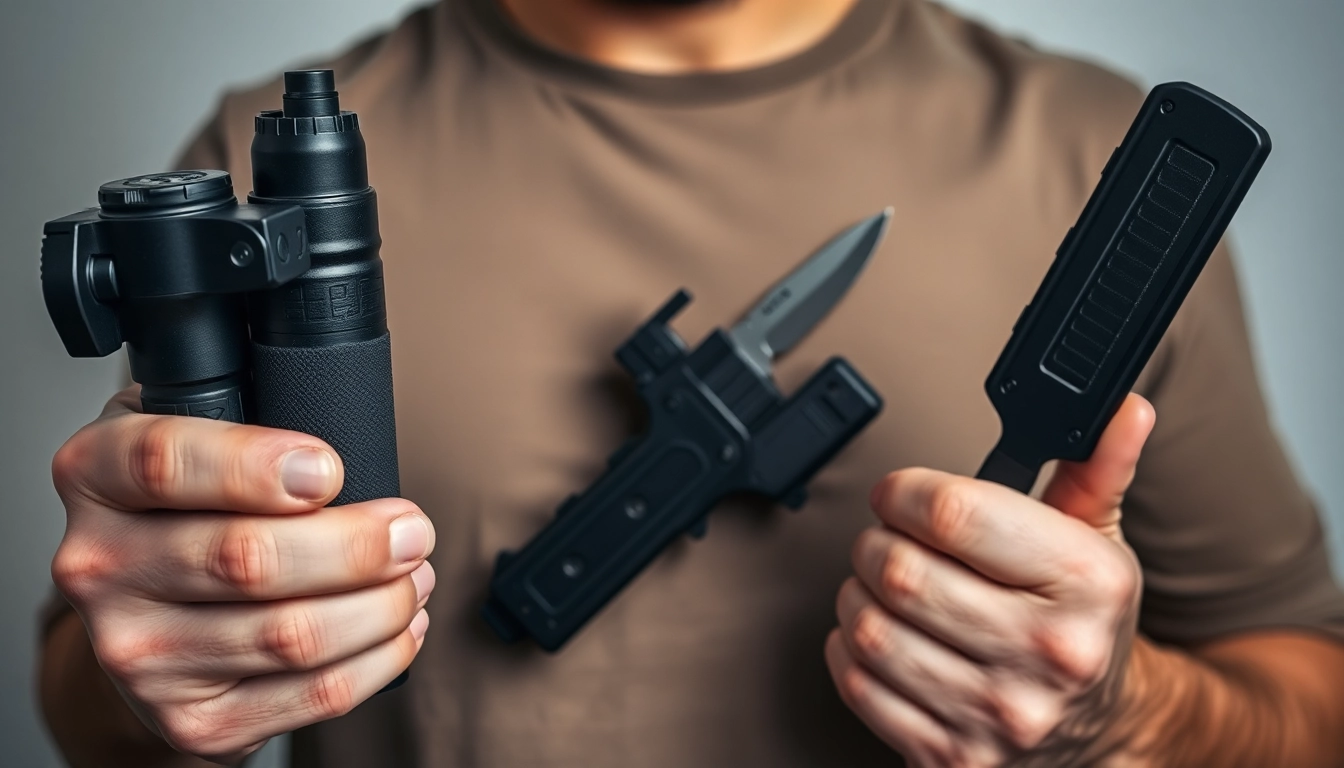Understanding Different Types of Self-Defense Weapons
In today’s unpredictable world, personal safety has become a top priority for many individuals. Whether commuting, jogging, or simply navigating daily routines, arming oneself with effective self-defense tools is essential. The landscape of self-defense weapons is diverse, spanning from non-lethal gadgets designed for quick deterrence to lethal implements intended for serious threats. Recognizing the distinctions and legal considerations associated with each type can help you make informed choices aligned with your safety needs and legal compliance.
For those seeking immediate protection without the risk of causing lethal harm, non-lethal self-defense options are often preferred. These include pepper sprays, stun guns, personal alarms, and self-defense keychains. They serve as effective tools for temporarily incapacitating an attacker, enabling you to escape or seek help. On the other hand, lethal weapons, such as firearms and certain knives, require thorough understanding of local laws and responsible handling.
To explore a comprehensive range of self-defense weapons and their features, visit our dedicated Self-Defense Weapons guide. Here, you’ll find detailed information on how each category can be integrated into your personal safety strategy.
Non-Lethal Self-Defense Options
Overview of Non-Lethal Weapons
Non-lethal self-defense weapons are designed to incapacitate or deter an attacker temporarily without causing permanent injury or death. Their primary aim is to give victims a window of escape and to avoid legal complications often associated with lethal force. Common devices include pepper sprays, stun guns, personal alarms, and specialized self-defense keychains.
Pepper Spray
Pepper spray is among the most popular non-lethal self-defense tools. It contains capsaicin, a compound derived from hot peppers, which causes immediate eye irritation, breathing difficulty, and temporary blindness. Its compact size makes it easily portable, and law enforcement agencies often recommend it as a deterrent. However, potential users should be aware of regional restrictions, as some states or countries impose limits on its possession.
Stun Guns and Tasers
Stun guns and tasers deliver an electric shock, disrupting muscular control and incapacitating an attacker momentarily. They are highly effective in close-range situations and often come with features such as flashlight integrations. Training in their use enhances efficacy, and regular maintenance ensures functionality when needed. Importantly, local laws vary significantly; in some areas, stun guns may be prohibited or require permits.
Personal Alarms
Personal alarms emit loud, attention-grabbing sounds, often exceeding 120 decibels. They are legal in most regions, simple to activate, and serve both as a deterrent and a call for help. Many models come with LED lights or siren features. Ideal for children, elderly individuals, and travelers, personal alarms are a non-invasive way to increase safety.
Self-Defense Keychains and Disguised Devices
These are small, portable devices disguised as everyday accessories like keychains, lipsticks, or pens. They often incorporate pepper spray or stun features. Their discreet design allows users to carry them seamlessly, providing quick access during an emergency.
Lethal Self-Defense Weapons and Their Legalities
Firearms and Handguns
Firearms are the most recognized lethal self-defense tools. They offer long-range protection and high stopping power but come with significant legal, safety, and ethical considerations. Laws governing firearm possession, carry permits, storage, and usage differ widely across jurisdictions. Responsible handling, training, and regular maintenance are non-negotiable to prevent accidents or misuse.
Knives and Edged Weapons
Knives, especially folding or fixed blades, are common self-defense weapons due to their portability and effectiveness in close contact. However, many regions classify certain knives as illegal or require permits to carry them. Using knives as self-defense must be approached responsibly, understanding that aggressive or reckless use can lead to legal consequences.
Legal Restrictions and Considerations
Laws related to lethal weapons are complex and vary not only by country but also by states, counties, and cities. For example, some jurisdictions restrict possession of certain knife types, while others impose strict firearm regulations. It’s crucial to familiarize yourself with the local legislation and obtain necessary permits before carrying or using lethal self-defense weapons. Additionally, ethical considerations emphasize proportionality—using lethal force should always be a last resort, justified only during imminent threat.
Consulting legal experts or law enforcement agencies can help clarify permissible self-defense weapons in your area, ensuring compliance and responsible use.
Choosing the Right Self-Defense Weapon for Your Lifestyle
Assessing Personal and Environmental Factors
Selecting an appropriate self-defense weapon requires an honest assessment of your lifestyle, environment, and comfort level with certain tools. Urban dwellers may prefer compact, discreet devices like pepper sprays or personal alarms, whereas outdoor enthusiasts might opt for larger, more durable options such as batons or tactical knives.
Consideration of Mobility and Portability
The effectiveness of a self-defense tool is often linked to how easily it can be carried and accessed. Smaller devices like keychain alarms or compact pepper sprays fit comfortably in pockets or handbags, making them quick to reach. Weight and bulk should be balanced against the need for concealability and ease of deployment.
Legal and Ethical Implications
Every jurisdiction has regulations dictating which weapons are legal to carry openly or concealed. Ensuring legal compliance prevents potential criminal charges and unwanted legal consequences. Ethical considerations focus on responsible usage—avoiding escalation and understanding situations that warrant self-defense versus those that don’t.
Matching Self-Defense Tools to Personal Skills
Your ability to effectively use a weapon significantly impacts its efficacy. Engaging in self-defense training or martial arts can enhance confidence and safety. For instance, if you are trained in hand-to-hand combat, certain blunt instruments may serve as adjuncts, whereas firearm or stun gun users should prioritize proper handling techniques.
Ultimately, the best weapon is one aligned with your lifestyle, legal allowances, and personal comfort, coupled with adequate training.
Key Features to Consider When Selecting Self-Defense Weapons
Portability and Concealability
The ideal self-defense weapon should be easy to carry discreetly. Devices like personal alarms, small sprays, and compact knives excel in this area. They enable silent carry and quick access, which are crucial in critical moments. Consider ergonomic designs that fit comfortably in your hand or pocket and do not draw unnecessary attention.
Ease of Use and Accessibility
A self-defense tool must be intuitive to activate under stress. Insights from experts show that simplicity—such as a single-button activation or quick draw mechanism—enhances effectiveness. Regular practice or drills can increase muscle memory, ensuring readiness when needed.
Legal Restrictions and Safety Measures
Always verify that your chosen weapon complies with local laws. Safety features like safety locks on stun guns or pepper spray caps prevent accidental discharge. Proper training reduces accidental injuries and ensures you know how to use your device correctly.
Best Practices for Using Self-Defense Weapons Effectively
Training and Familiarity
Knowledge of how to operate your self-defense device is paramount. Enroll in certified self-defense classes, firearm safety courses, or practice with dummy targets regularly. Familiarity reduces hesitation, increases confidence, and enhances your ability to act swiftly during stressful encounters.
Situational Awareness and Prevention
The most effective self-defense begins long before an attack occurs. Maintaining awareness of your surroundings, avoiding risky areas, and trusting your instincts are vital. De-escalation skills and conflict avoidance reduce the likelihood of needing to deploy a weapon.
Proper Maintenance and Storage
Regularly inspect and maintain your self-defense tools. Replace expired or malfunctioning devices, clean sprays, and check batteries in electronic gadgets. Store them securely but within easy reach—ideally, in a designated safe zone known to you alone.
Legal Regulations and Safety Tips for Self-Defense Weapons
State and Local Laws Overview
Laws governing self-defense weapons vary dramatically. For example, in some states, pepper spray is unrestricted, whereas others restrict its size or potency. Firearm laws involve registration, licensing, and carrying restrictions. Staying current with your jurisdiction’s legislation is essential—what’s legal today might change tomorrow.
How to Legally Carry and Use Self-Defense Weapons
Typically, lawful carrying of self-defense tools involves permits, especially for firearms. Concealed carry laws are also in effect in many regions. Always carry your weapons responsibly, keeping them secure from unauthorized access, particularly if children are present.
Ethical Considerations and Responsibility
Using self-defense weapons ethically involves understanding that they are meant to protect, not to harm unnecessarily. Use only proportional force in response to threat levels. Post-incident, report the event to authorities, and be prepared to explain your actions clearly.
Innovative Self-Defense Weapons and Future Trends
Technological Advancements
Rapid advancements are transforming the self-defense landscape. Compact and smart devices now incorporate GPS tracking, biometric access, and even connection to mobile apps for remote alerts. These innovations enhance safety, accountability, and ease of use.
Smart Self-Defense Devices
Devices such as smart pepper sprays with integrated alarms or GPS can notify contacts instantly and record incidents. Some security systems connect to wearable tech, providing real-time alerts to emergency services. Such tools exemplify how technology continues to expand personal safety options.
Emerging Market Options and Accessibility
The market is witnessing an influx of affordable, high-tech self-defense devices suitable for various budgets and lifestyles. Evolving regulations are gradually allowing wider access while emphasizing responsible ownership. Education on legal and effective use remains crucial as new products enter the scene.


















